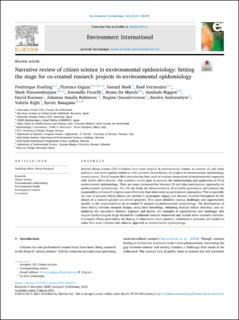| dc.contributor.author | Froeling, Frederique | |
| dc.contributor.author | Gignac, Florence | |
| dc.contributor.author | Hoek, Gerard | |
| dc.contributor.author | Vermeulen, Roel | |
| dc.contributor.author | Nieuwenhuijsen, Mark J. | |
| dc.contributor.author | Ficorilli, Antonella | |
| dc.contributor.author | De Marchi, Bruna | |
| dc.contributor.author | Biggeri, Annibale | |
| dc.contributor.author | Kocman, David | |
| dc.contributor.author | Robinson, Johanna | |
| dc.contributor.author | Grazuleviciene, Regina | |
| dc.contributor.author | Andrusaityte, Sandra | |
| dc.contributor.author | Righi, Valeria | |
| dc.contributor.author | Basagaña, Xavier | |
| dc.date.accessioned | 2022-01-24T07:44:38Z | |
| dc.date.available | 2022-01-24T07:44:38Z | |
| dc.date.created | 2021-06-21T15:13:50Z | |
| dc.date.issued | 2021 | |
| dc.identifier.issn | 0160-4120 | |
| dc.identifier.uri | https://hdl.handle.net/11250/2838818 | |
| dc.description.abstract | Several citizen science (CS) initiatives have been adopted in environmental science to monitor air and noise pollution, and water quality related to civic concerns. Nevertheless, CS projects in environmental epidemiology remain scarce. This is because little attention has been paid to evaluate associations of environmental exposures with health effects directly. This narrative review aims to promote the understanding and application of CS in environmental epidemiology. There are many commonalities between CS and other participatory approaches in environmental epidemiology. Yet, CS can foster the democratization of scientific governance and enhance the sustainability of research projects more effectively than other existing participatory approaches. This is especially the case in projects where citizens are invited to participate, engage and become involved throughout all the phases of a research project (co-created projects). This paper identifies various challenges and opportunities specific to the implementation of co-created CS projects in environmental epidemiology. The development of more locally relevant research designs, using local knowledge, obtaining medical ethical clearance, and co-analysing the association between exposure and health, are examples of opportunities and challenges that require epidemiologists to go beyond the traditional research framework and include more outreach activities. Continued efforts, particularly the sharing of information about projects' collaborative processes, are needed to make CS a more concrete and cohesive approach in environmental epidemiology. | en_US |
| dc.language.iso | eng | en_US |
| dc.publisher | Elsevier | en_US |
| dc.rights | Attribution-NonCommercial-NoDerivatives 4.0 Internasjonal | * |
| dc.rights.uri | http://creativecommons.org/licenses/by-nc-nd/4.0/deed.no | * |
| dc.title | Narrative review of citizen science in environmental epidemiology: Setting the stage for co-created research projects in environmental epidemiology | en_US |
| dc.type | Journal article | en_US |
| dc.type | Peer reviewed | en_US |
| dc.description.version | publishedVersion | en_US |
| dc.rights.holder | Copyright 2021 Published by Elsevier Ltd. | en_US |
| dc.source.articlenumber | 106470 | en_US |
| cristin.ispublished | true | |
| cristin.fulltext | original | |
| cristin.qualitycode | 1 | |
| dc.identifier.doi | 10.1016/j.envint.2021.106470 | |
| dc.identifier.cristin | 1917387 | |
| dc.source.journal | Environment International | en_US |
| dc.relation.project | EC/H2020/824484 | en_US |
| dc.identifier.citation | Environment International. 2021, 152, 106470. | en_US |
| dc.source.volume | 152 | en_US |

